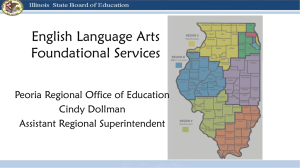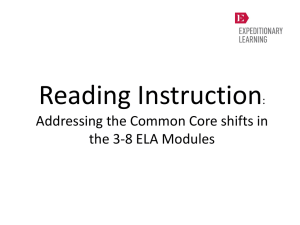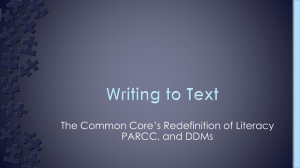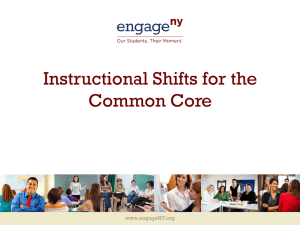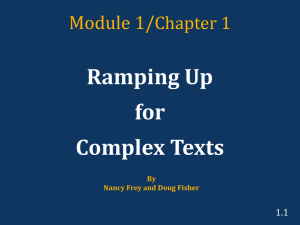Kindergarten - 5th Grade
advertisement
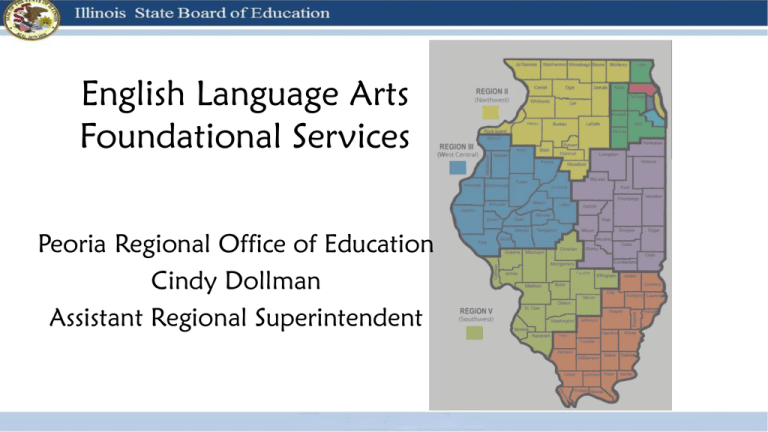
English Language Arts Foundational Services Peoria Regional Office of Education Cindy Dollman Assistant Regional Superintendent Multi-Tiered System of Support (MTSS/RtI) Statewide System of Support Priority Focus Foundational Focus Areas: - Continuous Improvement Process (Rising Star) - Common Core ELA - Common Core Math - Teacher Evaluation - Balanced Assessment The CCSS Shifts Build Toward College and Career Readiness for All Students 3 What Are the Shifts at the Heart of PARCC Design (and the Standards)? 1. Complexity: Regular practice with complex text and its academic language. 4 What Are the Shifts at the Heart of PARCC Design (and the Standards)? 2. Evidence: Reading and writing grounded in evidence from text, literary and informational. What Are the Shifts at the Heart of PARCC Design (and the Standards)? 3. Knowledge: Building knowledge through content rich nonfiction. Nine Specific Advances in the PARCC ELA/Literacy Assessment Demanded by the Three Core Shifts. . . 7 The CCSS Shifts Build Toward College and Career Readiness for All Students Text Complexity Close Reading Academic Vocabulary 8 Shift 2: Reading and writing grounded in evidence from text, literary and informational 4. PARCC focuses on students rigorously citing evidence from texts throughout the assessment (including selected-response items). 5. PARCC includes questions with more than one right answer to allow students to generate a range of rich insights that are substantiated by evidence from text(s). 6. PARCC requires writing to sources rather than writing to decontextualized expository prompts. 7. PARCC also includes rigorous expectations for narrative writing, including accuracy and precision in writing in later grades. Increased emphasis on Analysis of individual texts Argument and evidence Informative/explanatory writing Frequent short, focused research projects Comparison and synthesis of multiple sources Decreased emphasis on Narrative, especially personal narrative Writing in response to decontextualized prompts The CCSS Shifts Build Toward College and Career Readiness for All Students Text Dependent Questions Writing to Sources Narrative Writing 11 Defining: Research Claims for ELA/Literacy ELA/Literacy for Grades 3–11 Master Claim Major Claim: Reading Complex Text SC: Vocabulary Interpretation and Use SC: Reading Literature SC: Reading Informational Text SC: Research Major Claim: Writing SC: Written Expression SC: Conventions and Knowledge of Language Grades 6 – 8 ELA & Literacy in content areas: “Conduct short research projects to answer a question… … drawing on several sources ….” Grades 9 – 12 ELA & Literacy in content areas: “Conduct short as well as more sustained research projects to answer a question … or solve a problem… synthesize multiple sources….” Citing Textual Evidence Text-Dependent Questions A coherent sequence of text dependent questions will scaffold students toward successfully completing the culminating task. Should ideas. relate to core understanding and key A Culminating Task “The title of this selection is ‘Because of Winn-Dixie.' Using your answers from the questions above and class discussion, explain why this is an appropriate title for the selection. Be sure to clearly cite evidence from the text for each part of your answer.” “Officer Buckle’s final safety tip is 'ALWAYS STICK WITH YOUR BUDDY.' How did he and Gloria each learn this lesson for themselves throughout the story?” Bands Standard One 11-CCR Increased Ability to Use Text Evidence 6-8 4-5 2-3 K-1 www.achievethecore.org Bands 11-CCR Standards Two through Nine Increasing Range and Complexity 9-10 Standard Ten 9-10 6-8 4-5 2-3 K-1 18 Reading Anchor Standard 1 Read closely to determine what the text says explicitly and to make logical inferences from it; cite specific textual evidence when writing or speaking to support conclusions drawn from the text. Writing Anchor Standard 9 Draw evidence from literary or informational texts to support analysis, reflection, and research. 2. Determine central ideas or themes of a text and analyze their development…. 3. Analyze how and why individuals, events, and ideas develop and interact over the course of the text. 5. Analyze the structure of texts, including how specific sentences, paragraphs, and larger portions of the text … relate to each other and the whole. 8. Delineate and evaluate the argument and specific claims in a text, including the validity of the reasoning…. Writing Anchor Standard 1 ◦ Write arguments to support claims in an analysis of substantive topics or texts, using valid reasoning and relevant and sufficient evidence. Speaking & Listening Anchor Standard 3 ◦ Evaluate a speaker’s point of view, reasoning, use of evidence and rhetoric. Speaking & Listening Anchor Standard 5 ◦ Present information, findings, and supporting evidence…. Model close reading Texts worth teaching in depth Draw students into the texts thru interesting sequences Pre-teach vocabulary or background DO NOT pre-teach content Design questions so students make their own judgments Allow the readers space and time to experience the texts Designate time for rich & rigorous conversations ARE NOT Low-level, literal, or recall questions Focused on comprehension strategies Just questions… ARE Can only be answered with evidence from the text Can be literal (checking for understanding) but must also involve analysis, synthesis, evaluation Focus on word, sentence, and paragraph, as well as larger ideas, themes, or events. Focus on difficult portions of text in order to enhance reading proficiency Can also include prompts for writing and discussion questions Group Activity Evaluating Question Quality: 1) Using the checklist provides, evaluate the following questions about Charlotte’s web. (individually) 2) In discussion, share your evaluation and support your thinking. (large group) In the beginning of the story, John Arable was going to kill a baby pig that was a runt. What is a runt? Explain why Mr. and Mrs. Arable believed having a runt was a problem. What did Fern name her pig. Describe what Fern did to take care of a newborn pig. Describe the barn. Explain how Wilbur escaped from his pen. Did he enjoy his freedom? List five words that describe Templeton. Why did Mr. Arable have an ax? What was Fern’s motive? Why did Wilbur have to leave Fern? Why was chapter three called “Escape?” How does the sheep frighten Wilbur in chapter 7? What did Mr. Zuckerman believe and why? What did Mrs. Zuckerman believe and why? EXAMPLES NON-EXAMPLES Scaffolding supports the text. Pre-reading activities allow the text to unfold itself to the reader, preserving the reading experience. Questions lead students deeper into the text and cause them to pay closer attention to it. The classroom experiences stay deeply connected to the text. Scaffolding supplants the text. Pre-reading activities pre-empt or deflate the reading experience “Connection” questions and discussions lead away from the text. Activities are not text-based. What are the main points in each paragraph, and what evidence did you draw upon in the text to determine these main points? What is the main overall idea of the passage, and what does each paragraph contribute? What is the narrator’s attitude toward the subject? What details made you think this? Step One: Identify the core understandings and key ideas of the text. Step Two: Start small to build confidence. Step Three: Target vocabulary and text structure. Step Four: Tackle tough sections head-on. Step Five: Create coherent sequences of text-dependent questions. Step Six: Identify the standards that are being addressed. Step Seven: Create the culminating assessment. 29 When you're writing or reviewing a set of questions, consider the following three categories: Questions that assess themes and central idea Questions that assess knowledge of vocabulary Questions that assess syntax and structure Team Work Activity Developing Text-Based Questions: 1) Read the assigned passage. 2) As a team, develop 2-3 textbased questions that include rigor, higher-level thinking skills, and critical thinking. 3) Read the second passage. 4) As a team, develop 2-3 textbased questions that require students to either integrate ideas from the two passages or identify conflicting information between the two. 5) Record your work on chart paper to share with the large group. No one right way to work with text dependent questions Scaffolding Supports: not asking easier questions or substituting simpler text Listening and speaking should be built into any sequence of activities along with reading and writing CCSS require ALL students to read and engage with grade appropriate complex text regularly. Writing in the Common Core An Overview “Writing is the primary basis upon which your work, your learning, and your intellect will be judged – in college, in the workplace, and in the community.” Marquette University Expresses who you are Make thinking visible Promotes ability to pose worthwhile questions Fosters ability to explain complex positions Refine ideas with feedback Anticipate readers’ needs Preserves ideas Builds understanding of how truth is developed Equips you with the communication and thinking skills needed to participate effectively in democracy. Writing • 1. Write arguments • 2. Write informative/ explanatory texts • 3. Write narratives • 4. Produce coherent writing • 5. Develop & strengthen writing • 6. Use technology • 7. Conduct research projects • 8. Gather & integrate information • 9. Draw evidence • 10. Write routinely Narrative • Narrative writing tells a story on a real or imagined event Informational/ Explanatory Opinion/ Argumentative • Explanatory writing gives information or explains what is difficult to understand • Argumentative writing gives an opinion on a topic and uses support to convinces the reader to agree with it Narrative Opinion/ Argumentative Elementary 35% Explain/ Inform 35% Middle School 30% 35% 35% High School 20% 40% 40% 30% Narrative: conveys experience, real or imagines, uses time as its deep structure Purpose Inform Instruct Persuade Entertain Beginning Middle End Narrative lead (Engage reader with conflict by using a description or an image) Context (Go back in time to described origins of conflict) Body (Retell the experience) Turn (Present a highpoint, the strongest conflict) Closing (Return to initial image and add an insight) Informational/explanatory writing: conveys information accurately Purpose To increase readers’ knowledge of a subject To help reader better understand a procedure or process To provide readers with enhanced comprehension of a concept All About ___________________ Two things I know about ____________ 1. 2. This is a picture of ____________________ First Next Last a short statement that covers the main points in a text or selection Use a topic sentence and a closing sentence Keep summary short (2 – 5 sentences) Write about the main ideas in the text, and leave out the small details Use key words from the text, and leave out repeated words and phrases Use synonyms and your own words to restate important points Students must be able to determine importance of information in a text, Note-taking Guides provide a structure for finding and recording the most important information presented. What I learned: What I already knew: Questions I have: Anything extra: Opinions in K – 5 Arguments in 6 - 12 Argument: reasoned, logical way of demonstrating writer’s position, belief, or conclusion is valid To change reader’s point of view To bring about some action on the reader’s part To ask the reader to accept the writer’s explanation or evaluation of a concept, issue, or problem Opinion Writing How you feel about something K – state an opinion or preference 1 – state an opinion and supply a reason 2 – state an opinion, supply reasons, and use linking words to connect them (e.g., because) 3 – state an opinion, provide reasons, and use linking words and phrases to connect them (e.g., since, for example) 4 – state an opinion, provide reasons that are supported by facts and details, and use words and phrases to link them (e.g., in order to, in addition) 5 – state an opinion, provide logically ordered reasons supported by facts and details, and use words, phrases, and clauses to link them (e.g., consequently, specifically) 55 How you feel about something Reason 1 Reason 2 Reason 3 Restate Opinion Introduce your claim (Make your point) Support claim with Evidence (Use facts from credible sources) Explain how evidence supports the claim (Creates cohesion between point & evidence) Create a link between each point (Creates cohesion throughout the piece) Human Line Graphs Solicit reasons from both sides of room Brainstorm reasons I like, adore, love, enjoy I dislike, despise, detest I think I agree I disagree I feel I believe Like/Dislike • Adore • Love • Enjoy • Hate • Detest • Despise • Want Good/Bad • Great • Wonderful • Nice • Terrific • Best • Delicious • Terrible • Horrible • Disgusting Pretty/Ugly • Cute • Beautiful • Handsome • Gorgeous • Attractive • Unattractive • Plain • Unsightly • Horrid • Hideous Important • Not important • Necessary • Not necessary • Should • Must • Have to • Need • Ought to Thinking Words • Hard • Easy • Think • Too + _____ • Thought • Know • Believe • Feel • Very • Extremely • Boring • Interesting • Strange • Exciting I disagree with _____ because _____. I agree with _____ because _____. I think _____ because _____. My theory is _____ because _____. My claim is _____ because _____. I predict _____ because _____. I question _____ because _____. I infer _____ because _____. Students must create a balanced response. Integrating Interpretation of Text Text-based Support Prompt Statement Key Idea Explanation Support from Text Closing Statement Restate the question Answer the question Citing from the stimulus x2 End your Response Restate the question with key word(s) Answer the question (thesis statement) Citing Evidence x2 and Clarify Ending the Response RACE Strategy R Restate the question. A Answer the question. C Connection (textto-text, text-toself, text-toworld) For example… E Ending sentence restating your main idea. That is why… Constructed Response (routinely) Narratives 4th & 5th: two to three Analyses 4th : three to four 5th: three to five Research Project (one) Cite Evidence Analyze Content Study and Apply Grammar Study and Apply Vocabulary Conduct Discussions & Report Findings CCR.W.10 Write routinely over extended time frames (time for research, reflection, and revision) and shorter time frames (a single sitting or a day or two) for a range of tasks, purposes, and audiences. Writing to learn tasks Response to short text selections Open ended questions Informal writing projects Notes Summaries Learning Logs Response to short selections Open ended questions Dual Entry Journals Research projects Multimedia products Formal compositions with multiple revisions Modeled Shared Guided Independent INTRODUCES Teacher demonstrates writing strategies Teacher provides a proficient model Teacher models the writing process OPPORTUNITY FOR ALL TO SUCCEED Writing task is shared by teacher and students Writing comes from students’ thoughts and ideas Teachers identify and discuss conventions, structures, and language WORKING WITH GROUPS Develops independence Students work on specific skills and strategies (teacher observation) Context of authentic writing tasks Students develop self-monitoring skills PRACTICE Write for authentic purposes Write with a variety of styles Teacher conferencing “Published”works Notebooks in which students record their thoughts about a text. Write one word that was important to your reading today. Write one sentence that shows what was important in your reading today. Write a fact or piece of information about one part that would be interesting to discuss with a partner or group. • Sketch one part you found to be interesting. Use captions or labels to show what is happening. • Write your opinion about this book or section. Use ideas from the text to support your thinking. • Write down what you think are the main ideas. • Write about a connection you made to the book. • Write about a connection between this book and another book. • • • Provide opportunities for students to share their journals with you or with a partner. LITERATURE Title: Author: Characters and Traits: Setting: Problem: Solution: I made a connection, prediction, inference, questions, visualization (select one) and describe: INFORMATIONAL TEXT Title: Author: Main Idea: Detail: Detail: Detail: Summary: New words I learned: New information that I learned from the text: Interactive journals are notebooks in which students participate in short written conversations about what they are reading. To introduce the process, provide each student with a notebook, showing where to write or draw, and where to leave room for a peer to respond. Let students know that the journals will be a place for sharing ideas about their reading. 83 1. Instruct student-teams to decide on a selected amount of text to read closely and to then be prepared to exchange their thoughts in writing. To get the written conversations started, the students can brainstorm some generic prompts or you can offer your own. 2. At the agreed-upon stopping point, students write their responses and then trade journals to respond to the partner. They may exchange journals two or three times during a reading session, deciding on new prompts and stopping points as they go. 84 Writing to Sources Analytical writing tied to literary and informational texts; writing in response to texts; writing about texts Students analyze the text, make valid claims about the text, and support those claims with evidence from the text. Writing arguments and informational reports from sources Using evidence from texts to present careful analyses, well-defended claims, and clear information Generating reports from research; writing from multiple sources Grades K – 2: “Participate in shared research and writing project ….” Grades 3 – 5: “Conduct short research projects … that build knowledge … of a topic Grades K – 2 “… Recall information from experiences or gather information from provided sources … .” Grades 3 – 5 “Recall information from experiences or gather information from print and digital sources … .” 4th grade (literature) ◦ 4.RL.2. Determine a theme of a story, drama, or poem from details in the text. 4th grade (informational text) ◦ 4.RI.6. Compare and contrast a firsthand and second hand account of the same event or topic; describe the differences in focus and the information provided. 5th grade (literature) ◦ 5.RL.3. Compare and contrast two or more characters, settings, or events in a story or drama, drawing on specific details in the text (e.g., how characters interact). 5th grade (informational text) ◦ 5.RI. 6. Analyze multiple accounts of the same event or topic, noting important similarities and differences in the point of view they represent. 6th grade ELA (literary nonfiction) ◦ 6.RI.8. Trace and evaluate the argument and specific claims in a text, distinguishing claims that are supported by reasons and evidence from claims that are not. 8th grade ELA (literature) ◦ 6.RL.3. Analyze how particular lines of dialogue or incidents in a story or drama propel the action, reveal aspects of a character, or provoke a decision. 9-10th grade Literacy (informational text) ◦ 9-10.RH. 9. Compare and contrast treatments of the same topic in several primary and secondary sources. ◦ 9-10.RST.8. Assess the extent to which the reasoning and evidence in a text support the author’s claim or recommendation for solving a scientific or technical problem. Extensive practice on short, focused research projects More typical of the workplace Allows students to repeat the research process many times and develop the expertise needed to conduct research independently A progression of shorter research projects also encourages students to develop expertise in one area by confronting and analyzing different aspects of the same topic as well as other texts and source materials on that topic More sustained research efforts at higher grades Team Discussion Writing Prompts ‘before’ an ‘after’ the Common Core 1) Read ‘before’ and ‘after’ writing prompts for each grade level. 2) Identify the differences between the ‘before’ and ‘after.’ 3) As a team, discuss: 1) 2) How differences reflect the intent of the Common Core How this will impact your instructional practices Mentor Texts Graphic Organizers Engaging 21st century learners Step 1. Study the photograph for 2 minutes. Form an overall impression of the photograph and then examine individual items. List people, objects, and activities in the photograph. Step 2. Inference Based on what you have observed above, list three things you might infer from this photograph. Step 3. Questions What questions do these photographs raise in your mind? Now choose one and use that question to formulate a short analysis. If a picture says a thousand words… Photos as Springboards to Writing Taken from www.timeforkids.com What does a video say? 31 secs Start at 1:12 3:28 4:17 1:12 Focus: writing types rather than writing process Writing is strongly connected to the reading standards Language standards should be incorporated into writing Writing standards includes a research component Students must write every day Establishing a 45 minute writing block allows for students to work through the writing process Give students choices Students are motivated by their own experiences and interests Establish routines Set high expectations and build stamina PARCC Model Content Frameworks Types of Writing Evidence Tables Rubrics Illinois Writing Matters Rubrics Exemplars Mentor Texts On-Demand Writing Talking comes 1st Write 3 new things you learned… Write 2 questions you have…. Write 1 thing you will implement in your classroom…. Thank You Peoria Regional Office of Education Cindy Dollman, Assistant Reg. Supt. cdollman@peoriaroe48.net


